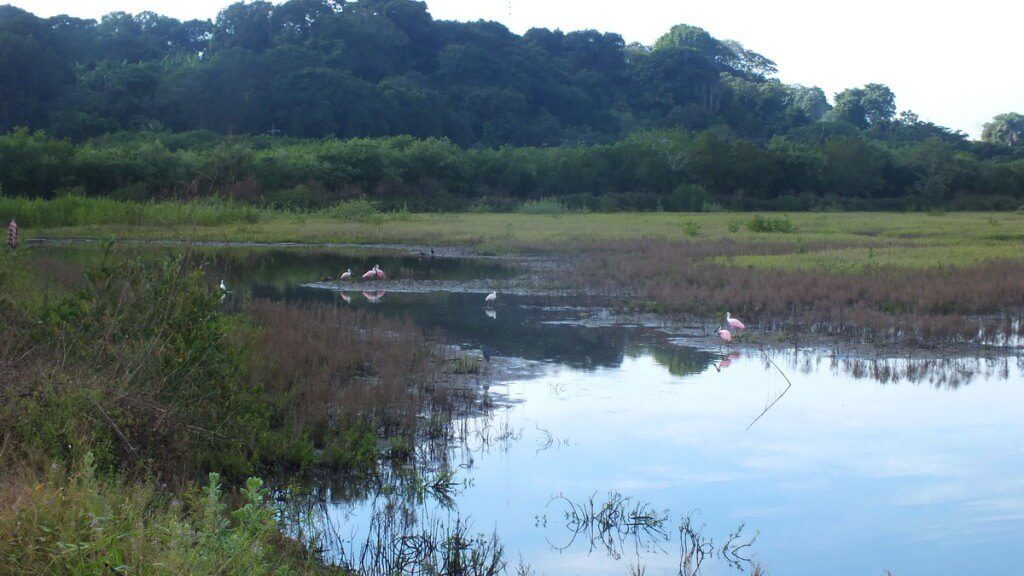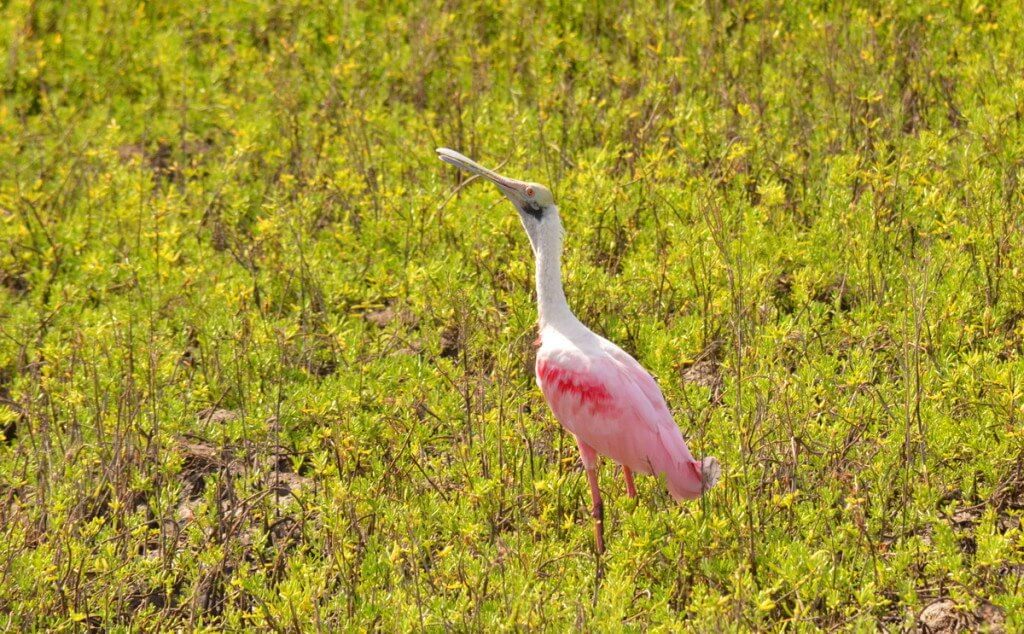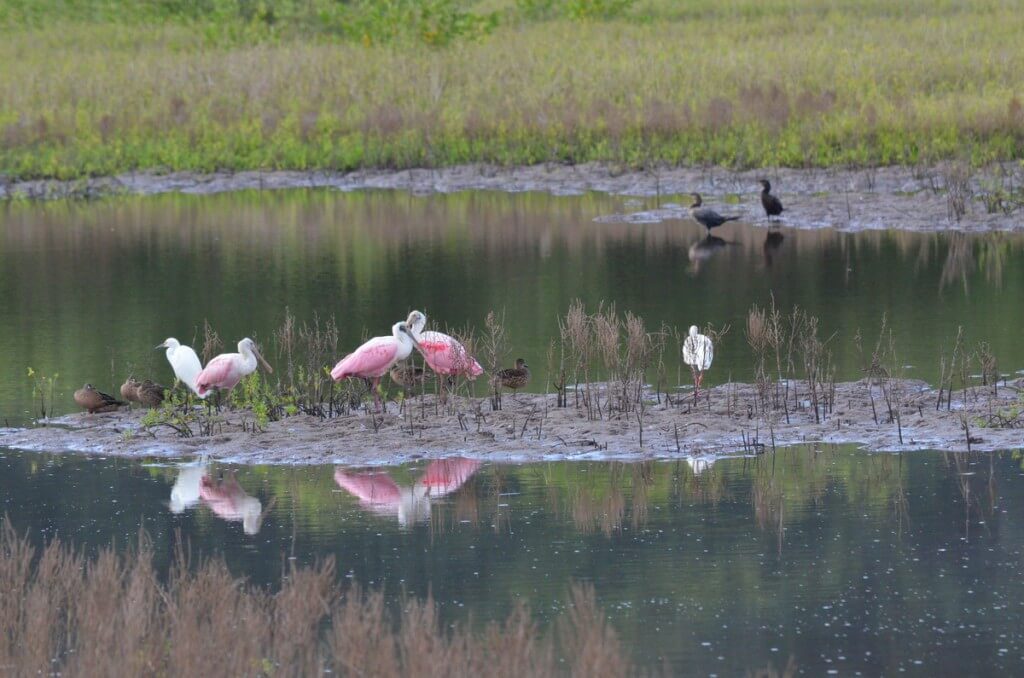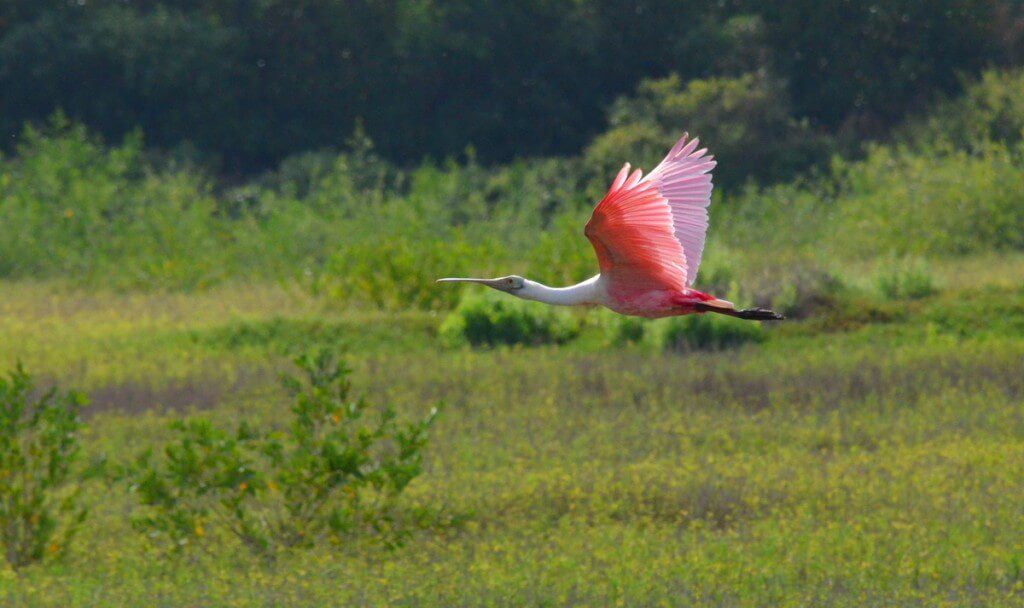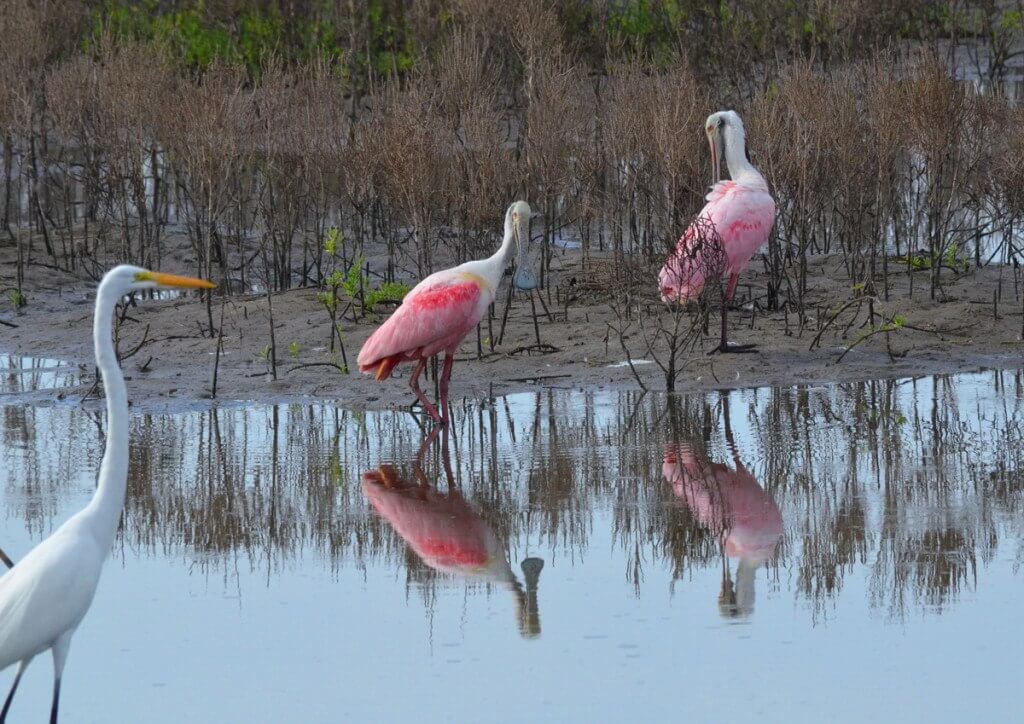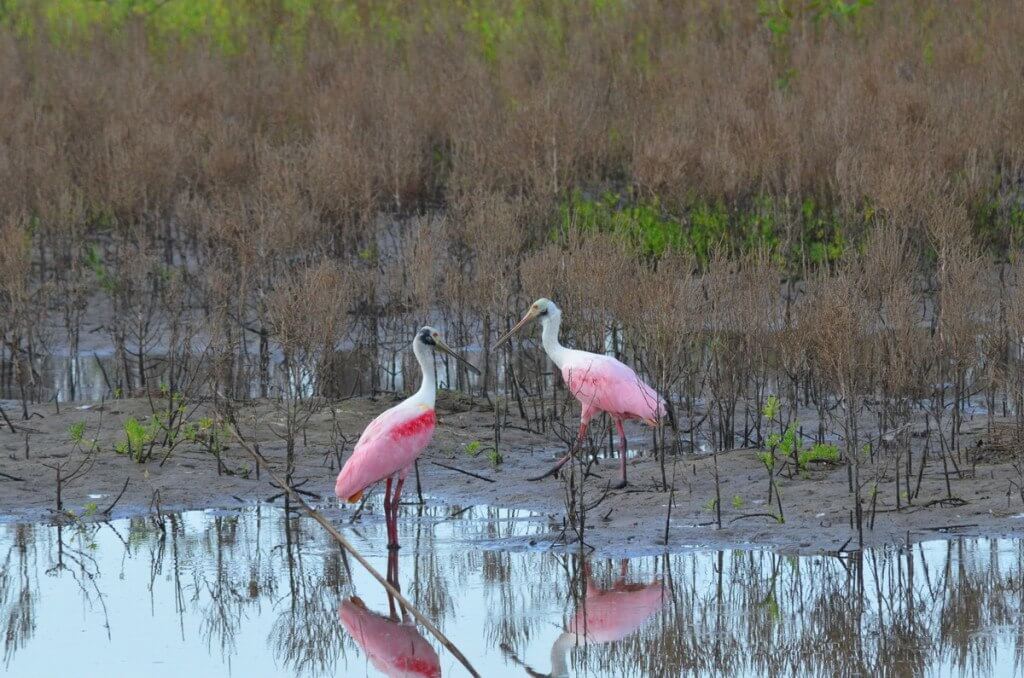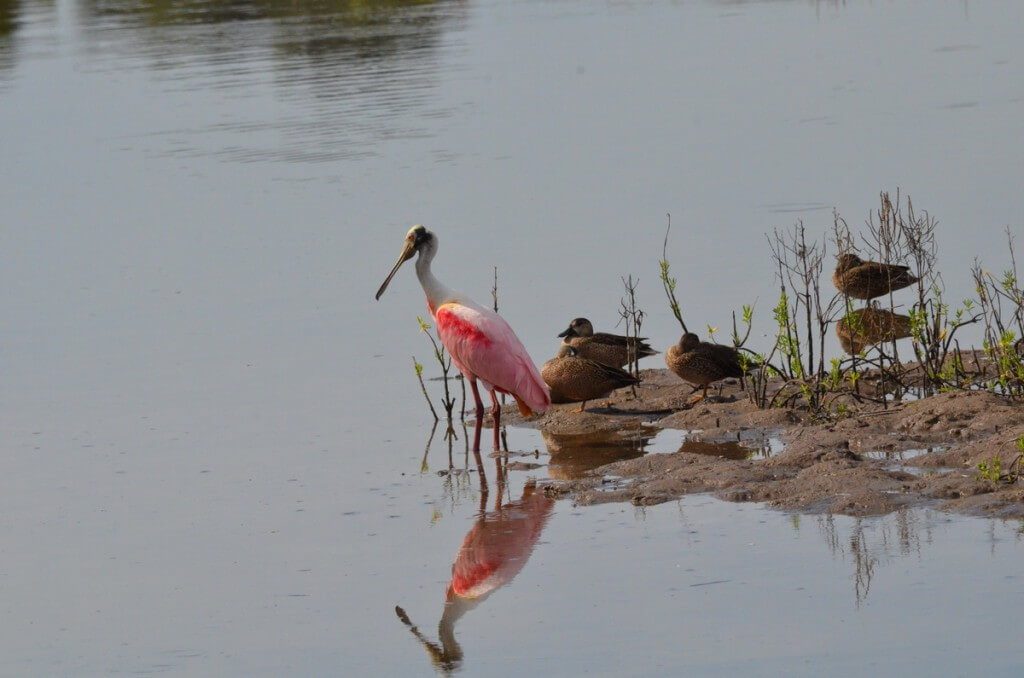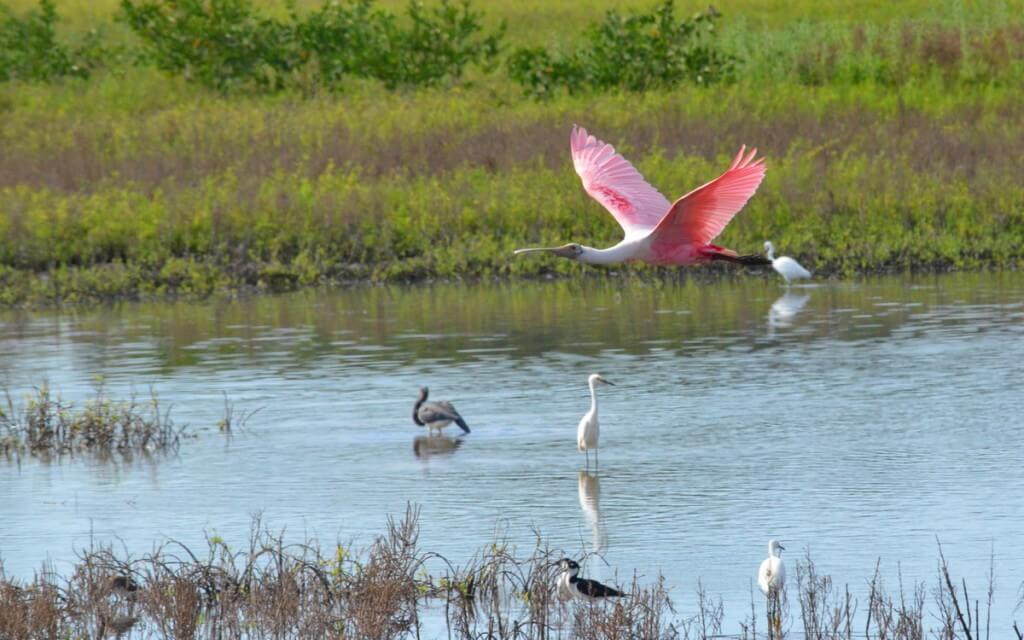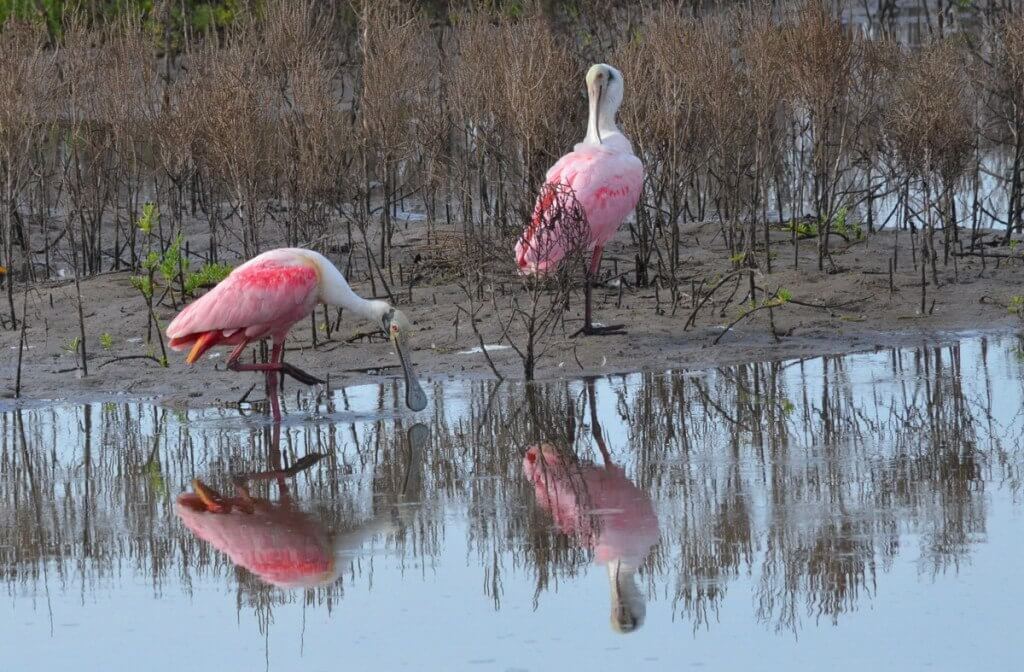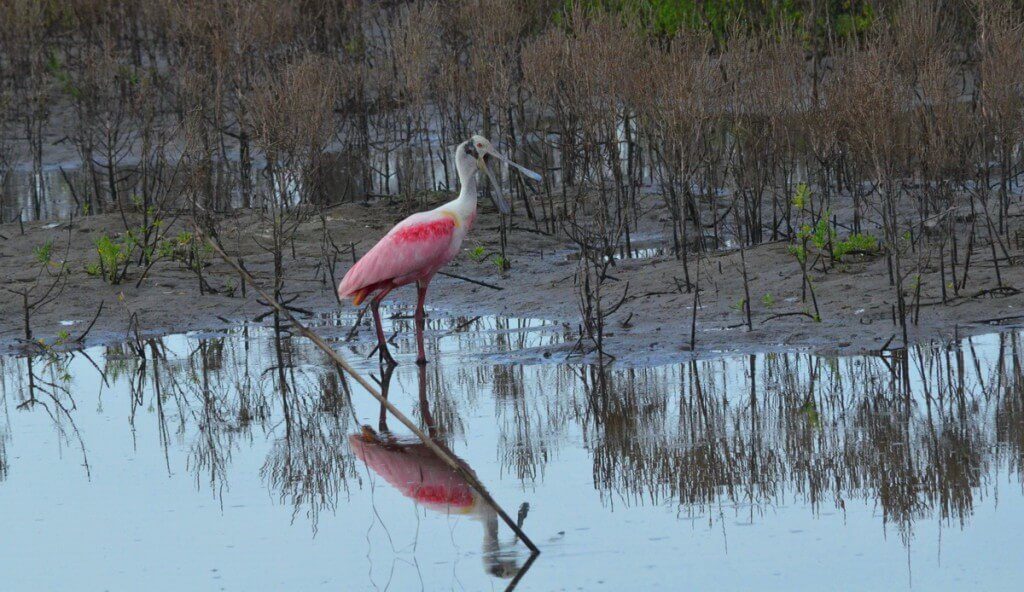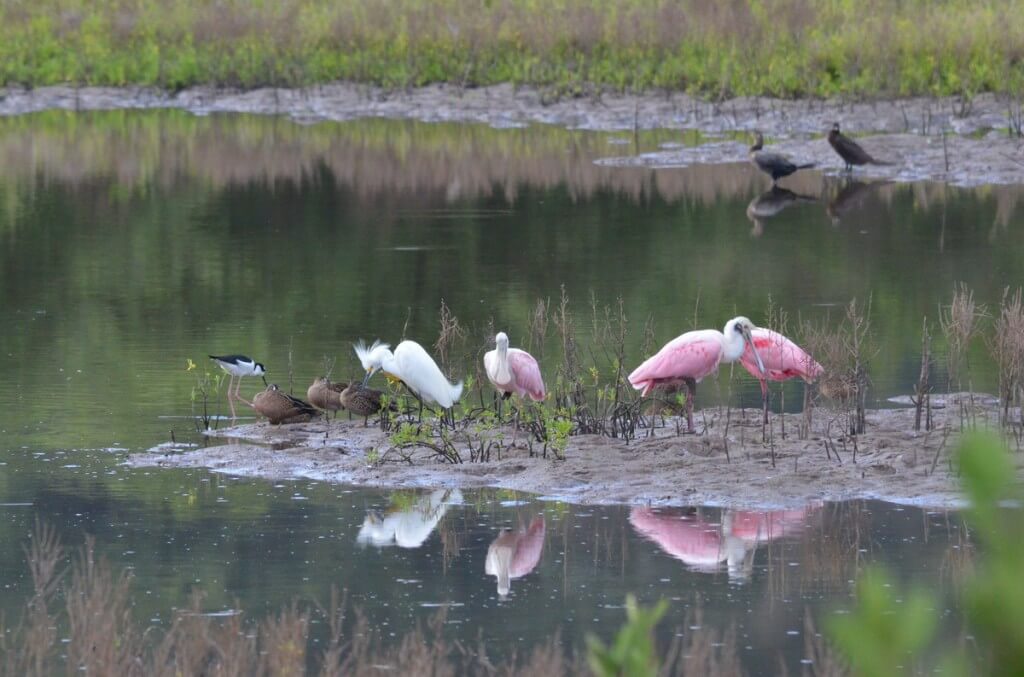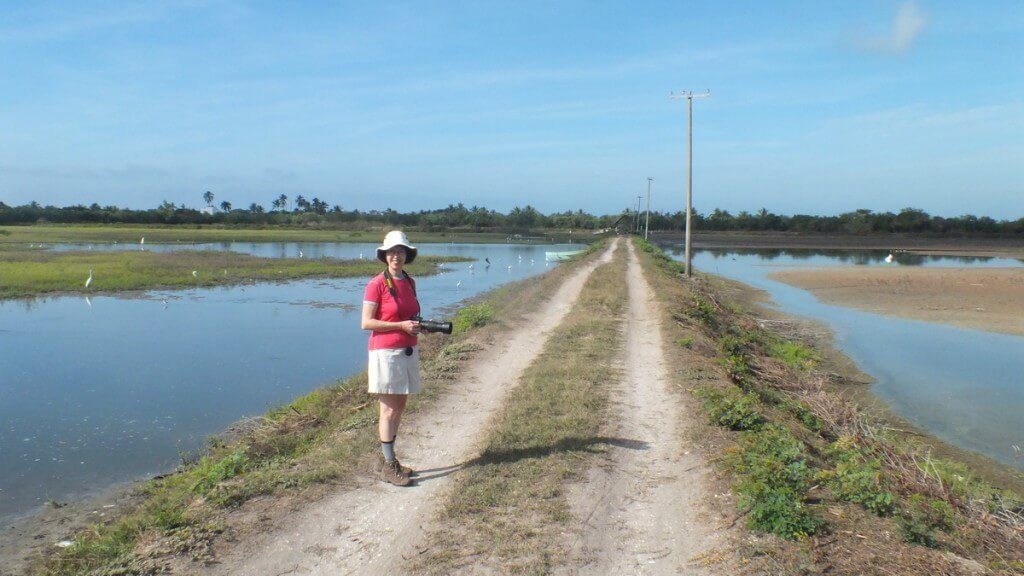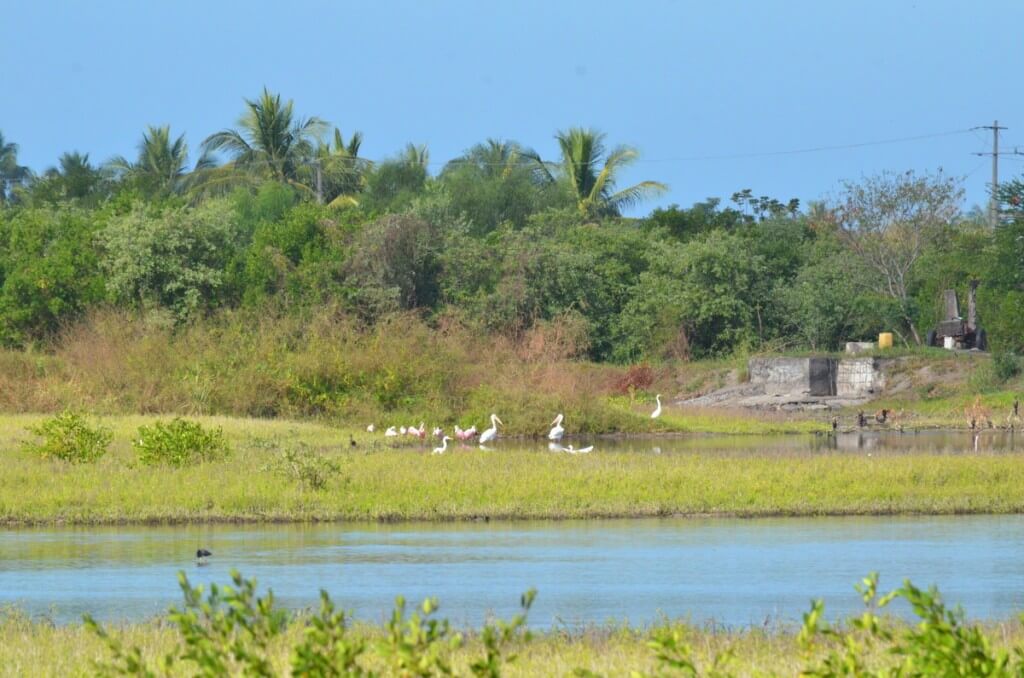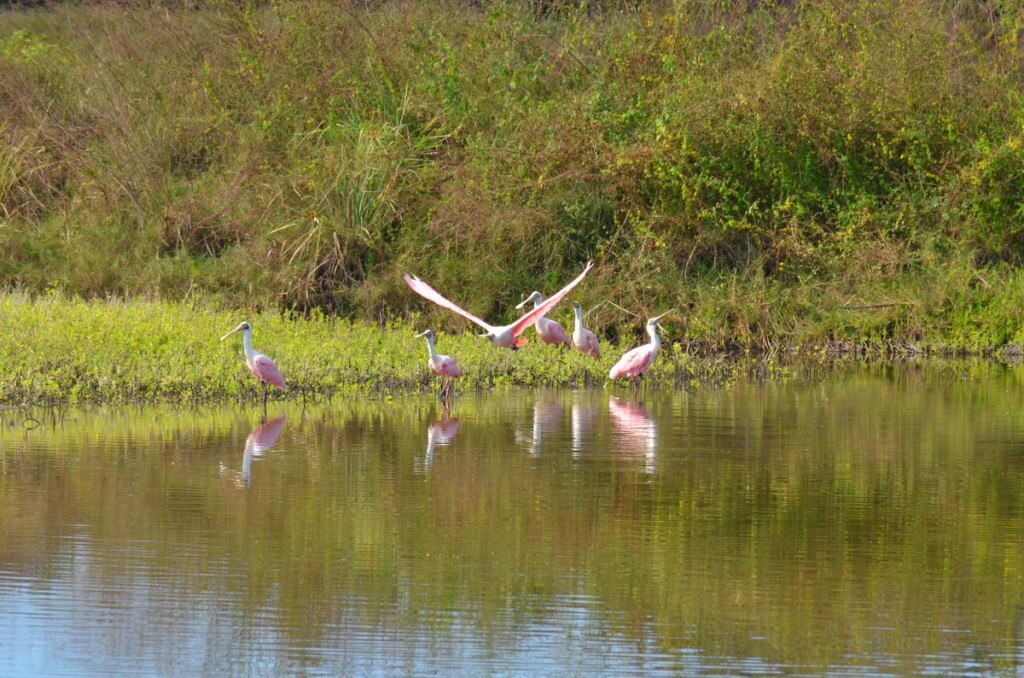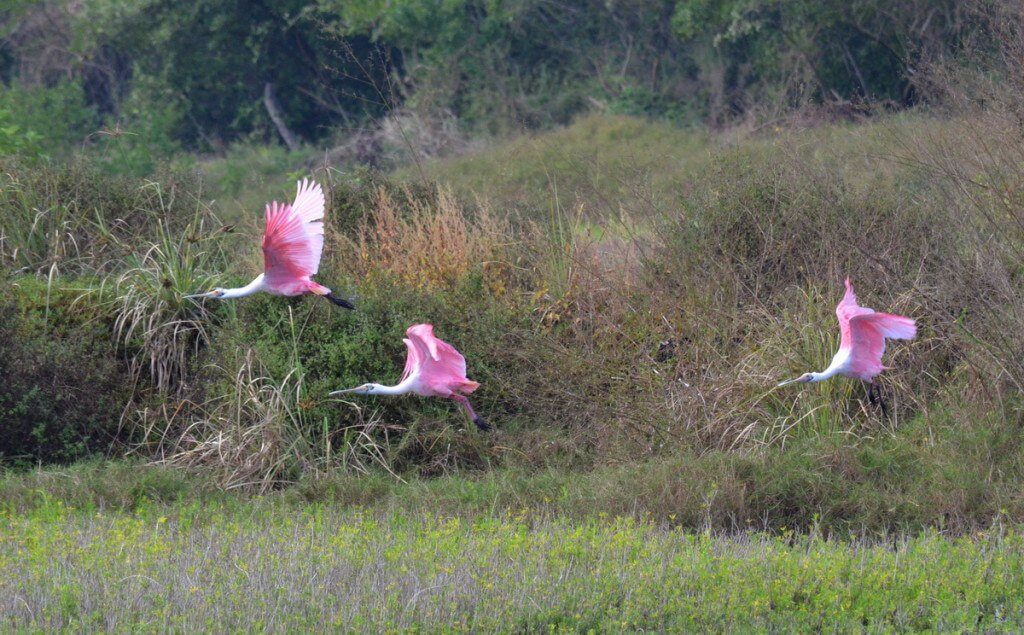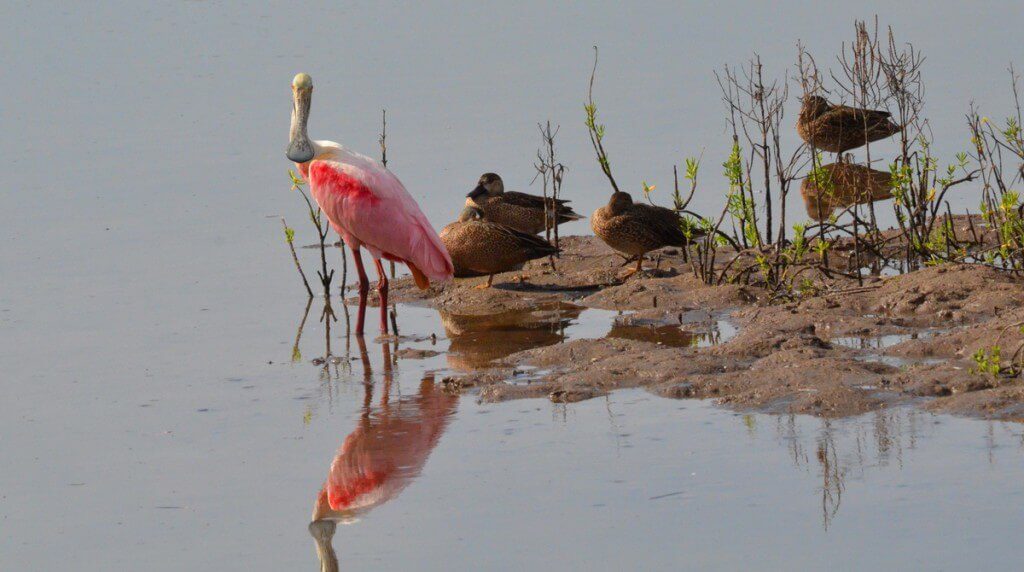Roseate Spoonbills In The Shrimp Ponds At San Blas
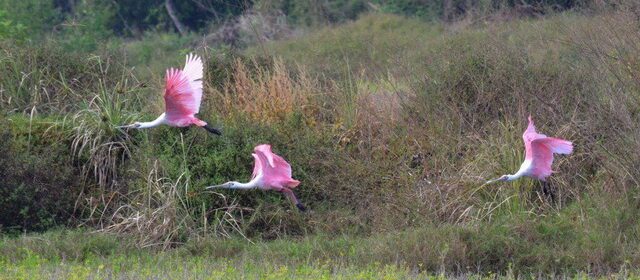
As Bob and I arranged our winter vacation in Mexico, we made a change to the plans that would allow time for birdwatching in San Blas on the Pacific Coast. That decision had us discovering myriad species of birds in that coastal area including some Roseate Spoonbills at the local Shrimp Ponds one morning. We were delighted!
A visit later the same day to the crumbling remains of the Fort of San Basilio, located on a hill on the northeast side of town, provided this aerial view of the Shrimp Ponds that are, themselves, a short distance outside of town.
After parking the car on a berm that borders the east side of the Shrimp Ponds, We quickly hopped out and wandered along the raised bank towards a cluster of shorebirds in the near distance. A prompt about turn was required because sand flies swarmed us erupting from the fine, dry sand like clouds of dust. After a quick application of insect repellent, we were on our way again but still my legs were burning from the first onslaught of bites.
The Shrimp Ponds cover an area of several hectares, and in every direction that we looked, there were shorebirds and among them numerous Roseate Spoonbills. Because shrimp and crabs are raised in the vast spread of shallow lagoons, it is a magnet for wading birds. Where we disembarked from the car, a young man was on site checking the intake of water. He pulled one crab from the water for us to look at.
Roseate Spoonbills belong to the Ibis and Spoonbill family of birds. There are six Spoonbill species that inhabit warm tropical climates across the world, but it is only the Roseate Spoonbills that live in the western hemisphere.
Roseate Spoonbills are very social birds, and because of the type of habitat where these birds live, it is not uncommon to find them in large colonies and sharing the space with various other species of shorebirds such as Ibises, Egrets, Herons and Cormorants, all of which we saw at the Shrimp Ponds.
The Roseate Spoonbill’s preference for shallow muddy water has them frequenting mangrove swamps, either fresh or saltwater lagoons, inland marshes, and tidal pools where they feed in the early morning and evening hours.
Bob and I certainly saw good numbers of Roseate Spoonbills moving about the area of the Shrimp Ponds even though our arrival there was not all that early in the day, perhaps around 9 a.m.
I was mesmerized by the beauty of the Roseate Spoonbills and found their elongated spoon-shaped bills fascinating. Not only does the pristine white head and chest make the birds appear elegant, but the delicate pink shading of the plumage contrasted by deep pink shoulder patches and legs results in an irresistibly gorgeous wading bird.
Bob and I soon took note of the differences in some of the Roseate Spoonbills. Those with a bald greenish head and grey bill are mature birds. They were accompanied by immature Spoonbills that have white feathers covering the head and a yellowish or sometimes pink-coloured bill. There was a good mix of both at the Shrimp Ponds. You will notice that the pink plumage on the immature bird is paler by comparison and lacks the bright red patch on the shoulders.
Much like Flamingos do, Roseate Spoonbills acquire their pink plumage because of the foods that they eat. I long had an understanding that it is their diet of shrimp that causes the feathers to turn pink, and the effect is cumulative: the plumage grows deeper pink as a Roseate Spoonbill (or Flamingo) grows older.
It is actually the shrimps’ diet of algae that is the source of the pigment. Algae produces red and yellow pigments identified as carotenoids, so shrimp are carotenoid-rich. The more shrimp that is consumed by a Roseate Spoonbill, the more pigment becomes deposited in its feathers. They can vary in coloration from pale pink to bright magenta.
Roseate Spoonbills forage for an assortment of creatures that include crustaceans, aquatic insects, mollusks, killifish, and small frogs. They are highly successful at detecting these animals in the muddy water because they have touch receptors in the bill that make it highly sensitive. As a Roseate Spoonbill steadily wades through the water, it sweeps its uniquely-shaped bill from side to side.
The sand on the muddy bottom is stirred up, and prey becomes trapped in small whirlpools of water. A Spoonbill is then able to sift through the suspended mud and strain out any food items including bits of aquatic vegetation. Two small slits located near the top of the bill enable a Roseate Spoonbill to breathe even when the beak is submerged.
There was a lot of competition going on for food found in the Shrimp Ponds. Snowy Egrets, Tri-coloured Herons, Great Egrets, Black-necked Stilts, American White Pelicans, to name a few, were among the other species vying for prey. It seemed that there was lots for everyone because the water was literally boiling with the action of schools of small fish.
It was a very relaxing experience to hike out on the causeways that separate the Shrimp Ponds. Bob and I were the only two people in the whole area, the young man having departed right after we arrived. The absolute silence was only gently disturbed by passing birds whose wing beats rhythmically stroked the air. It was divine, and as a result, two hours slipped by as we dawdled along looking at butterflies, lizards and birds.
At the far end of the Shrimp Ponds, numerous Roseate Spoonbills were feeding together in a small flock accompanied by a couple of American White Pelicans.
Next thing you know, several of these bizarre wading birds took flight toward my direction. Known for being shy birds, a whole colony of Roseate Spoonbills will take flight en masse if startled, but we had no idea what spurred the birds to take to the air.
With an approximate wingspan of 1.3 metres (1.5 yds), they made a most impressive sight gliding by above the still water with long, slow wingbeats. Unlike herons, Roseate Spoonbills fly with their necks stretched out in front of them, and as these specimens passed us overhead, it was impossible not to notice the black feet and vibrant orange tail feathers. Backlit by the noon day sun, they were striking.
A Roseate Spoonbill is an average-sized wading bird with a body that is 71-86 centimetres (28-34 in) long, and on long thin red legs, they stand about 84 centimetres (33 in) tall. Considered one of the most striking wading birds in all of North America, Bob and I would have to agree. Our day was off to a great start!
Frame To Frame – Bob and Jean



